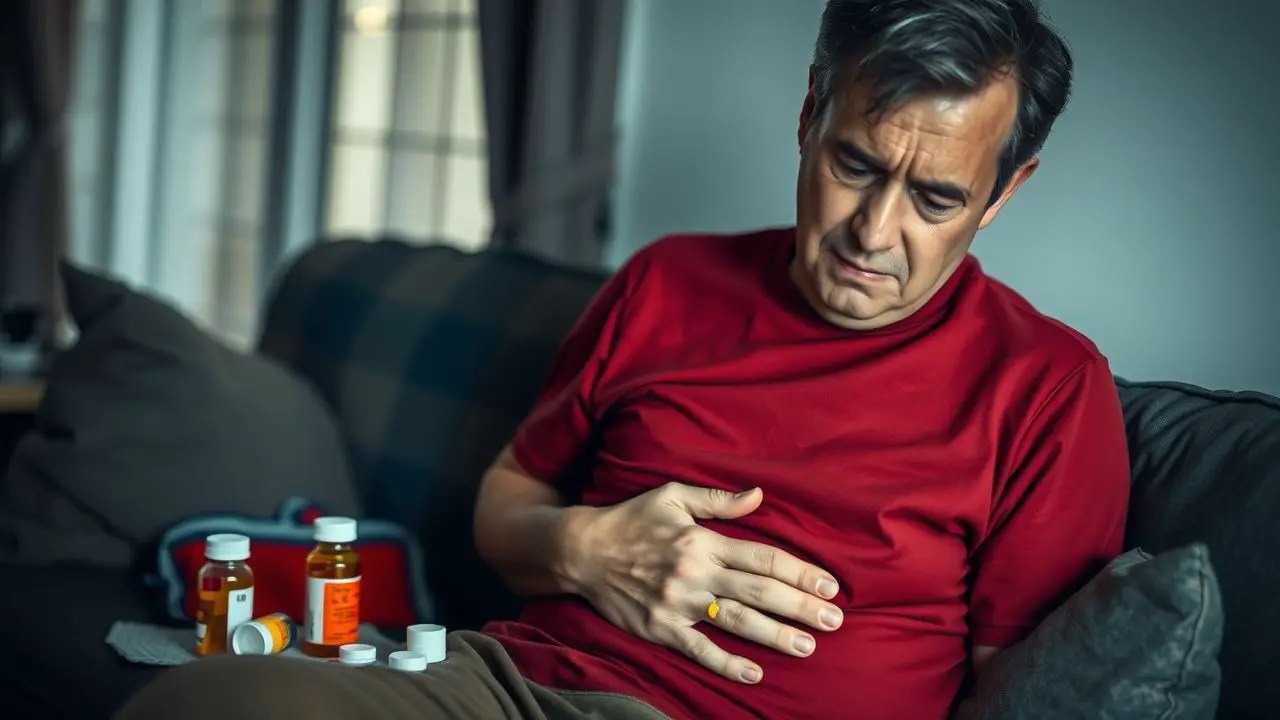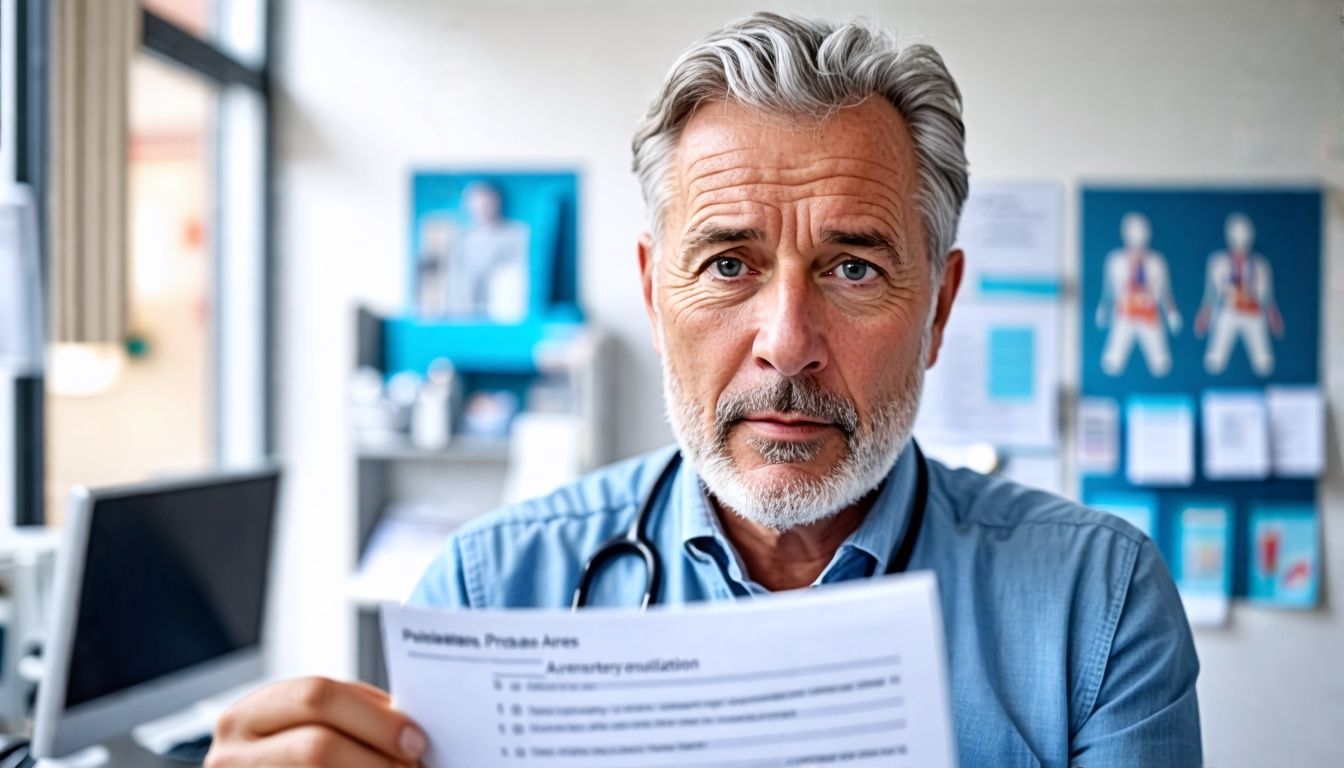Many men have questions about an enlarged prostate. Benign Prostatic Hyperplasia, or BPH, is a common condition as men get older. 2 This article will guide you through symptoms, causes, and how to treat them. 3 Read on for help with BPH. 1
Key Takeaways
- BPH is a common issue in older men, leading to problems like hard peeing and going a lot at night.
- Causes of BPH include aging, hormone changes, family history, and lifestyle factors such as being overweight.
- Treatment options range from watchful waiting for mild symptoms to medications, minimally invasive procedures, and surgery for severe cases.
- Keeping an eye on symptoms with regular doctor visits is key because half of the people with BPH will need treatment.
- Healthy living choices can help manage or lower the risk of developing BPH.

What is Benign Prostatic Hyperplasia (BPH)?

Benign Prostatic Hyperplasia, or BPH, is where the prostate gland grows larger. This growth isn’t cancerous and doesn’t raise the risk of prostate cancer. Still, it’s a common issue in men and those assigned male at birth as they get older.
By age 60, half of these individuals show symptoms, and by age 85, ninety percent have symptoms. Despite being benign, about fifty percent of people with BPH will need treatment because their enlarged gland can cause trouble with urinating. 1
BPH affects 29%-33% of men aged 65 and older.
Considering its impact on urinary function—like making it hard to start urinating or needing to go often—knowing how to spot signs early can lead to better handling of the condition.
Let’s explore what leads up to this enlargement in our next section.
Understanding Benign Prostate Lesion Rates
Men aged 40-64 have a prevalence of 5%-6% for benign prostatic hyperplasia, or BPH. This statistic significantly increases by age 85, with 90% of men experiencing this condition. From these, half begin indicating symptoms by the time they reach their sixties.
These statistics illuminate that as men age, the probability of developing an enlarged prostate escalates. The reasons connect to alterations in hormones and genetics over time.
Understanding these rates assists in identifying signs promptly. For instance, problems like difficulty urinating or the need to frequent at night are indicative of BPH. Armed with this insight, men can consult medical advice promptly if they observe such symptoms.
This proactive approach allows us to explore specific ways BPH impacts daily life through its symptoms. 23
Symptoms of Benign Prostatic Hyperplasia
If you’re finding it hard to pee, going a lot at night, or feeling like you can’t empty your bladder fully, these could be signs of Benign Prostatic Hyperplasia. Keep reading to learn what this means and what you can do about it.
Difficulty urinating
Having trouble starting to pee can be one of the first signs someone notices with an enlarged prostate. The prostate gland gets bigger and starts blocking the flow of urine. This makes it tough for men to start peeing, even when they really need to go.
The urine stream can be weak or stop and start again. Sometimes, after peeing, there might still feel like some urine is left that won’t come out. 3
Men may also find themselves needing to pee more often than before, especially at night. This leads into the next part about frequent urination and why it happens more at night due to BPH. 2
Frequent urination, especially at night
Frequent urination, especially at night, is a common issue for men with an enlarged prostate. 2 This condition can make you get up many times to go to the bathroom, disrupting your sleep.
The enlarged gland presses against the urinary tract, causing the bladder to think it’s full when it might not be. This leads to more trips to the bathroom. 2
Nocturia or increased urination at night can significantly impact one’s quality of life.
Because of this pressure on the bladder neck by the larger prostate gland, even when you try to empty your bladder completely, some urine often stays behind. Over time, this could lead to other problems such as urinary tract infections or bladder stones.
Each trip might also involve a weak stream and feeling like you haven’t fully emptied your bladder.
Weak urine stream
A weak urine stream means the flow of urine is not as strong as it should be. This can happen if the prostate gets larger, a condition known as benign prostatic hyperplasia or BPH.
The enlarged prostate presses on the tube that urine flows through. Because of this pressure, urine flows out slowly. 3
Men might notice it takes longer to finish urinating. They may also feel like they still need to go even after they’ve just been to the bathroom. These signs point to incomplete bladder emptying, another symptom linked with a weakened urine stream.
Treatments for BPH aim to ease these symptoms by reducing prostate size or relieving pressure so urine can flow more freely again.
Incomplete bladder emptying
Moving on from a weak urine stream, another issue men face with benign prostatic hyperplasia is incomplete bladder emptying. This means even after going to the bathroom, you might feel like your bladder isn’t fully empty.
It’s one of the urinary symptoms that can get worse over time. Men often notice they need to go again soon after leaving the restroom.
This problem happens because an enlarged prostate blocks part of the urinary tract. The block makes it hard for all the urine to leave your bladder. Risk factors like getting older and having a family history of prostate issues play big roles here.
If you have this problem, it’s important to talk to a doctor about treatments for BPH or look into lifestyle changes that could help. 2
Why Does Enlarged Prostate Cause Frequent Urination at Night?
An enlarged prostate, or benign prostatic hyperplasia (BPH), pushes against the urethra. This makes it hard for urine to flow out. 3 At night, this problem is worse because the body produces less urine-controlling hormones.
It means men wake up often to go to the bathroom. The bladder doesn’t empty completely with each visit. So, they feel the need to urinate again soon after.
This condition also leads to a weak urine stream and frequent trips to the toilet during day time too. But at night, without daytime activities to distract them, men notice these symptoms more.
Plus, lying down puts extra pressure on the bladder from the enlarged prostate gland. This increases the urgency and frequency of needing to pee during nighttime hours. 3
Causes of Benign Prostatic Hyperplasia
Changes in hormones, family history, and how you live your life can lead to an enlarged prostate. Dive deeper to understand more about what causes this common condition among men.
Hormonal changes with age
As men get older, their hormones change. These changes can lead to benign prostatic hyperplasia (BPH). After age 40, the risk goes up. 2 The body makes less testosterone and more estrogen.
This imbalance might make the prostate grow. 1
Age brings wisdom and sometimes enlarged prostate.
Doctors do not fully understand how these hormonal changes cause BPH. They study aging men to learn more about it. Knowing this can help find better treatments for an enlarged prostate.
Genetic predisposition
Genes play a big role in benign prostatic hyperplasia (BPH). About 40-70% of BPH cases link back to family genes. 4 This means if your dad or grandpa had issues with their prostate gland, you might too.
Some specific genes involved are those managing vitamin D and how the body handles steroids. Depending on where folks come from, certain gene changes affect BPH chances more.
Lifestyle also matters but don’t forget the genetic cards you’re dealt. Knowing your family’s health history helps understand your own risk for an enlarged prostate. Keep an eye on symptoms like difficulty urinating or needing to go a lot at night. 2 If these sound familiar, it might be time for a talk with your doctor about prostate health.
Lifestyle factors
After looking at genetic reasons for BPH, let’s talk about lifestyle choices. Being overweight and having diabetes make BPH more likely. 5 These are things you can change. Eating lots of veggies and staying active help lower your risk.
There haven’t been big studies on changing your habits to fight BPH, but it makes sense that healthy living helps.
Eating right and exercising do not just keep you fit; they also protect your prostate health. Small steps like walking more or adding greens to your meals can make a big difference.
It’s not simple, but taking care of your body helps avoid problems with an enlarged prostate later on.
Risk Factors for Developing BPH
Getting older plays a big role in the risk of developing BPH. A family history of prostate problems can also increase your chances.
Aging
The advancing years significantly influence the wellbeing of your prostate. Upon reaching the age of 40, the likelihood of men experiencing an enlarged prostate increases. 3 This is a result of hormonal alterations occurring with age progression.
The data indicates that around 29%-33% of men aged 65 and above are likely to develop benign prostatic hyperplasia (BPH), demonstrating that age is a dominant risk factor for this condition.
Age isn’t simply a numerical value concerning your prostate health.
Though lifestyle choices and family history play a role, the influence of aging is notable. The next topic of our discussion will be the role of genetic predisposition in BPH.
Family history
Family history plays a big role in Benign Prostatic Hyperplasia (BPH). Men with family members who have had BPH are more likely to get it themselves. They have an age-adjusted odds ratio of 1.3 for moderate to severe symptoms. 6 This means their chance is higher than men without this family link. Also, these men often face slower urinary flow rates, showing how genetics can affect prostate health.
Understanding your family medical background helps identify if you’re at higher risk for BPH. Knowing this early can guide decisions about checking your prostate health and taking action if needed.
Next, we’ll look into why an enlarged prostate causes frequent urination at night.
Obesity and metabolic syndrome
Obesity plays a big role in BPH. The more weight around the waist, the higher the chance of needing surgery for prostate enlargement. 7 Metabolic syndrome makes things worse. It includes high blood pressure, bad cholesterol levels, and sugar problems.
All these add up, increasing risks for BPH.
Waist size matters too. A larger waist points to a greater need for surgical treatments among men with enlarged prostates. 7 Eating healthy and staying active can help avoid this issue.
This keeps both weight and metabolic syndrome in check, lowering the risk for BPH complications.
Diagnosis of Benign Prostatic Hyperplasia
Finding out if someone has Benign Prostatic Hyperplasia starts with a visit to the doctor. They will do a physical check, ask for pee and blood samples, and might use special pictures of the inside of your body to see more.
Physical examination
Doctors use a physical exam called a digital rectal exam to check for an enlarged prostate. 8 During this test, a doctor feels the size of the prostate gland through the rectum. This helps them find out if it’s larger than normal. 3 They also talk about health history and symptoms with the patient.
A healthy outside starts from the inside.
They might do postvoid residual volume tests too. These show how much urine is left in the bladder after going to the bathroom. Both steps are important to diagnose benign prostatic hyperplasia or BPH without using hard-to-understand medical terms. 8
Urine and blood tests
After the doctor does a physical exam, they move on to urine and blood tests. Urine tests help rule out other conditions that look like BPH. 8 This means doctors can make sure something else isn’t causing the symptoms.
Blood tests check prostate health in more detail. They include checking PSA levels to see how the prostate is doing.
The PSA test is a key part of finding out if treatment is needed. High PSA levels might suggest problems with the prostate, but not always cancer. These tests give doctors important information on what steps to take next for managing BPH symptoms effectively. 8
Imaging studies
Imaging studies play a big role in looking at an enlarged prostate. Doctors use a special kind of ultrasound called transrectal ultrasound to get a close look. This tool helps doctors see how big the prostate has gotten.
It uses sound waves that bounce off the prostate, creating pictures.
The ultrasound is also key for guiding needles when taking tissue samples of the prostate. 8 This step is important to check if there are any signs of cancer or other problems besides benign prostatic hyperplasia (BPH).
These images help doctors understand the size and shape of the enlargement, making it easier to choose the best treatment plan.
Treatment Options for BPH
For those facing BPH, options range from simply watching symptoms to treatments that involve medicine or surgery. This includes taking drugs like alpha blockers, opting for less invasive procedures such as the prostatic urethral lift, or going for surgery in more severe cases.
Each approach has its own benefits and fits different needs — encouraging readers to explore further and find what might work best for them.
Watchful waiting
Watchful waiting is for mild cases of BPH where symptoms don’t greatly change daily life. Men choose this option and see their doctor regularly without taking strong action right away.
They keep an eye on their symptoms to make sure they don’t get worse. This approach suits those who want to avoid medicines or surgery. 1
Doctors suggest coming in for check-ups often during watchful waiting. They use tests like the digital rectal exam and PSA (prostate-specific antigen) blood test to monitor prostate health.
Men also pay attention to how often they urinate, especially at night, and whether they have a weak urine stream or trouble emptying their bladder completely. This way, if things change, they can decide with their doctor if it’s time for more active treatment. 9
Medications
Doctors often suggest medicine as a first step to treat enlarged prostate, also known as benign prostatic hyperplasia (BPH). 8 Two main types of drugs help with this problem. Alpha-blockers like Tamsulosin and Terazosin make it easier to urinate by relaxing bladder neck muscles and muscle fibers in the prostate.
They work fast, improving symptoms in days or weeks.
Another group, 5-alpha reductase inhibitors such as Finasteride and Dutasteride, shrink the prostate over time. They lower levels of a hormone that makes the prostate grow. This process takes longer — months, maybe — but it can help stop further growth and might even make the prostate smaller.
For men with larger prostates or more severe symptoms from BPH, doctors may recommend taking both kinds of medication together for better results. 9
Minimally invasive procedures
After looking at medicines, we see other ways to help with BPH. Minimally invasive procedures are key options. These don’t need big cuts and have less recovery time. Examples include the Prostatic Urethral Lift (UroLift), Rezum Therapy (steam injection), and Photoselective vaporization using a GreenLight laser. 10
These treatments fix urine flow without major surgery. They use tiny tools and cameras to make changes in the prostate. Many men get better fast and have fewer problems after these procedures.
With options like steam or laser, doctors can target just the trouble areas, leaving the rest of the prostate alone. This helps keep side effects low.
Surgical treatments
Doctors sometimes suggest surgery for a big prostate if other treatments don’t work. Two common surgeries are transurethral resection of the prostate (TURP) and transurethral incision of the prostate (TUIP).
TURP involves removing part of the prostate to relieve pressure on the tube that carries urine from your bladder. It helps with urine flow and can fix most symptoms. 9
Another option is laser surgery, where doctors use a high-energy light to take out or shrink parts of your prostate. This method is less invasive and often has fewer side effects, like less bleeding.
Robotic surgery is also an option for some men. Here, surgeons use tiny tools and robots to remove the prostate piece by piece. These surgeries can greatly improve quality of life but come with risks such as infection or problems with sexual function.
Safe Sleep Aids for Enlarged Prostate Sufferers
Finding the right sleep aid can be hard for men with an enlarged prostate. Many worry about side effects or if the treatment will work well with other medications. Good news comes from a study talking about using tamsulosin and zolpidem together.
Tamsulosin helps with urinary symptoms by relaxing muscles in the prostate and bladder neck. Zolpidem, on the other hand, can improve sleep without making bathroom trips at night worse.
Patients who were unhappy with just tamsulosin saw better sleep after adding zolpidem to their routine. This combo did not report serious side effects, which is comforting for many men looking for relief. 11 So, this approach might offer a safer way to handle nighttime urination without losing rest. It’s always best to talk with a doctor before starting new treatments to make sure they fit your health needs. 12
Conclusion
Learning about Benign Prostatic Hyperplasia, or BPH, helps men know what to expect as they get older. An enlarged prostate can make life hard, from frequent trips to the bathroom at night to trouble starting to pee.
The good news? There are many ways to manage these problems, from simple changes in diet and lifestyle to medicine and even surgery if needed. Knowledge is power. Understanding BPH means you can take control of your health with confidence.
FAQs
1. What is benign prostatic hyperplasia and what causes it?
Benign prostatic hyperplasia, or BPH, is a condition where the prostate gland enlarges. While the exact cause is not clear, changes in male sex hormones may play a role.
2. How can I tell if I have an enlarged prostate or benign prostatic hyperplasia?
Common symptoms of BPH include frequent urination, weak urine stream, urinary retention and lower urinary tract symptoms. If you experience these issues regularly, consider scheduling a digital rectal exam for further investigation.
3. Can benign prostatic hyperplasia lead to other health concerns?
Yes, untreated BPH can result in serious health issues such as bladder stones and kidney problems due to acute urinary retention. It’s crucial to seek medical attention if you notice blood in your urine or any persistent urinary symptoms.
4. Are there non-surgical treatments available for managing benign prostatic hyperplasia?
Absolutely! Non-surgical treatments like alpha blockers can help manage symptoms of BPH by reducing prostate size. Other options could be herbal supplements or medications like Proscar and Flomax.
5. What surgical options are there for treating an enlarged prostate due to benign prostatic hyperplasia?
Several surgical procedures exist for treating BPH including transurethral resection of the prostate (TURP), transurethral incision of the prostate (TUIP) and minimally invasive surgeries like photoselective vaporization of the prostate or even laparoscopic procedures.
6. Does treatment for benign prostatic hyperplasis affect sexual function?
Some men might experience sexual side effects after surgery – this includes retrograde ejaculation or erectile dysfunction but these are typically temporary conditions that resolve with time.
References
- ^ https://my.clevelandclinic.org/health/diseases/9100-benign-prostatic-hyperplasia
- ^ https://www.mayoclinic.org/diseases-conditions/benign-prostatic-hyperplasia/symptoms-causes/syc-20370087 (2024-09-24)
- ^ https://www.niddk.nih.gov/health-information/urologic-diseases/prostate-problems/enlarged-prostate-benign-prostatic-hyperplasia
- ^ https://pubmed.ncbi.nlm.nih.gov/39554302/
- ^ https://pubmed.ncbi.nlm.nih.gov/21045705/
- ^ https://pubmed.ncbi.nlm.nih.gov/7572978/
- ^ https://pmc.ncbi.nlm.nih.gov/articles/PMC3162215/
- ^ https://www.mayoclinic.org/diseases-conditions/benign-prostatic-hyperplasia/diagnosis-treatment/drc-20370093 (2024-09-24)
- ^ https://pmc.ncbi.nlm.nih.gov/articles/PMC8021971/
- ^ https://pmc.ncbi.nlm.nih.gov/articles/PMC9936536/
- ^ https://pmc.ncbi.nlm.nih.gov/articles/PMC3921753/
- ^ https://pmc.ncbi.nlm.nih.gov/articles/PMC10268417/



